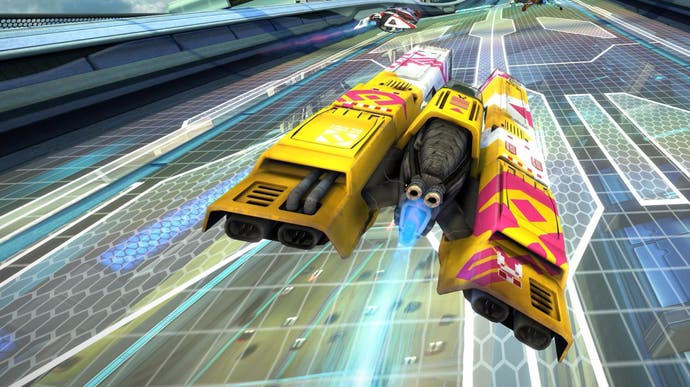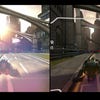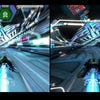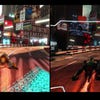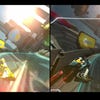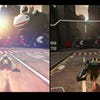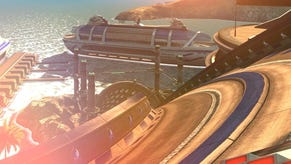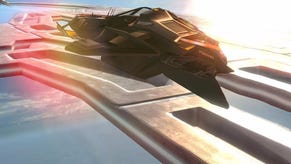WipEout on PSVR: an upgrade with no compromises?
The PS4 Pro original vs its new VR companion.
WipEout and virtual reality should be a match made in heaven - and Sony's new PlayStation VR upgrade more than delivers. While there have been some changes to the visual make-up of the game, the sheer quality of the original release remains in place, making VR a genuine upgrade here with few drawbacks. The stark cutbacks we've seen elsewhere in other titles in terms of content, visual quality and shading don't seem to apply to WipEout VR - it's still a beautiful experience. More than that though, this isn't just a straight port: genuine effort has gone into enhancing the experience specifically for the VR medium.
But let's tackle graphics first. What we know about WipEout Omega Collection from the outset is that the developers have overhead here. PlayStation 4 Pro renders the standard game at full 2160p with a faultless 60 frames per second, so there's more than enough GPU fill-rate and compute power to handle PSVR's 1080p display. Indeed, Pro delivers a super-sampled 1620p experience, dropping just a touch to 1512p on the base PS4. Essentially, right off the bat, WipEout is a great candidate for a VR port - there's no need to double frame-rate (as required in DriveClub VR) and little need to pare back the visual feature set. Indeed, both PS4 and Pro versions even retain the 4x8 EQAA hardware anti-aliasing of the original release.
Perhaps the most daunting challenge is in doubling geometry throughput, required for a true stereoscopic output, but more importantly, we get the idea that a fair amount of work has been carried out in adapting a visual design aimed at today's living room flatpanels for a very specific VR display: an OLED panel no less, mere centimetres from the user's face. There are two major visual differences between the standard Omega Collection and its VR off-shoot; one that's easily explained and another that is a little more of a mystery.
To kick off with, motion blur is gone - almost certainly a decision aimed at a more presentable VR experience. Blurring an image right in front of your eyes really isn't a great idea, so turning this off is a smart move. More curious is the second change: lighting is more subdued and bloom is visibly reduced - though not disabled. The difference ranges from a non-issue in some levels to quite stark in others - particularly in the WipEout 2048 stages - but it doesn't quite feel like a downgrade within the headset, more like a tweak. A fair amount of post-process effects in today's rendering engines are designed to mimic the human eye's reactions to specific condition, which may seem superfluous in a VR environment.
Beyond that, model quality, level of detail and all other aspects of the WipEout Omega Collection presentation make their way across to virtual reality untouched, and it's from here that the developers shift their focus to making WipEout work better in VR. First of all, it is a little disappointing to see WipEout's beautiful pre-race flybys removed, but instead, you get something better - a chance to sit in the beautifully rendered cockpit of your ship, and to just... well, look around. With VR, you're now present on the circuit and in the ship. You're on the big stage and you can feel that - it's an immense experience.
Once the race begins, an overhead shield drops in around the cockpit, managing to introduce a claustrophobic element to the presentation - I found myself literally leaning forward as I shot up one of WipEout's signature loops to get a better view. If the constricted view is not good for you, the standard game's two chase cam views are available and changes are made to the HUD, expanding it out so as not to intrude in your general view (though looking away from the action to see what position you're in during the race can have somewhat unfortunate consequences). Beyond that, it's WipEout as we know it and love it with the same tracks, the same event structures, the same modes and, crucially, the same silky smooth performance of the original game.
Yes, the VR version retains the same 60 frames per second performance target as the standard Omega Collection, as opposed to using the overhead available to target 90Hz instead - an optional mode for PSVR developers. Interpolation is used to bring the output up to 120Hz, but this is mostly about offering lower latency to headset movement as opposed to offering a smoother overall frame-rate. Stepping through a 120Hz capture step-by-step, it's interesting to see the main renderer operating on every other frame, with the spatial headset adjustment clearly visible throughout the entire feed. In common with our PSVR titles using this technique, it can cause a little ghosting, especially evident on lateral movement (most obviously when you look left or right at passing scenery).
The action comes at you with WipEout's signature speed, jumps and bumps - and although it will depend on the individual's stomach, motion sickness is likely to be a problem. The more you play, the more fast motion you're exposed to that isn't present in the real world, which starts to cause issues. Continued exposure even to basic gameplay can cause issues, but some of the more extreme courses actually come with specific warnings, automatically engaging pilot assist, meaning less chance of a jarring jump when hitting a corner.
WipEout HD Fury's 180 degree spin in combat mode also offers up a warning of potential motion sickness, but the bottom line is that the entire experience in full flow is somewhat akin to an all-out assault on the senses - and it's recommended to explore the various camera options and consider pilot assist. Another alternative - and the one I chose - is simply to play the game in smaller sessions (three races is about my limit).
There's little quarter given to the player here - the action is relentless - but that's WipEout, and I'm not sure I'd want it any other way. There are ways and means to enjoy a less frenetic experience - non-combat races and zone runs aren't quite as much of a sensory assault, but the game is what it is: a zero compromise, enhanced VR port of one of the very best remasters available for PlayStation 4.
Cockpit-based games have a tendency to work nicely in virtual reality and the Omega Collection proves this point once more - but the big takeaway here is a really important one, specifically that VR really is a free, value added extra here. You don't pay for it, whether we're talking about handing over physical cash or giving away visual quality in order to make the VR effect possible. This remaster was always worth investing in whether you were playing on PS4 or the Pro - and now it's just as essential to the PlayStation VR library. .
